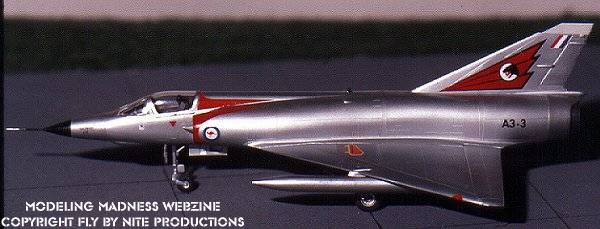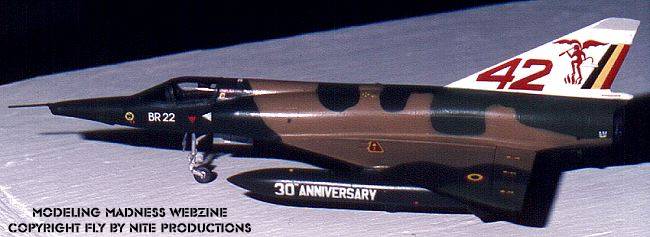
Heller 1/72 Mirage III/5
Kit Number: 253 or 323 (same kit; different box)
Price: about $10.00 (in 1985)
Media: injected plastic
Decals: Two versions; one French and one Belgian
Date of Review: 6 May 1998
Review and Photos by: Scott Van Aken

France's premier interceptor/fighter for the 1960's and 70's was the Mirage III. A very similar aircraft, the Mirage 5, was initially built for Israel, but embargoed due to the 1967 war. Versions of both the III and 5 were widely exported in large numbers allowing the modeler a vast number of possible paint schemes for this aircraft. While no longer in service with most countries, the legacy lives on in the Kfir and South Africa's Cheetah.
Heller's kit can be built as either a IIIE/IIIR or Belgian 5BA/5BR. Unfortunately, it takes some modifications to make other Mirage 5 versions as the Belgian version is unique in the nose area. Fortunately, a recce nose is part of the kit so that helps increase the number of versions buildable right from the box. The kit is typical for the times; raised panel lines, minimal cockpit and wheel well detailing. In addition, the main landing gear is extremely weak and the wheels are toy-like in appearance having no detailing. All this aside, once it's weaknesses and building idiosyncrasies are discovered and overcome, it makes into a very nice kit. I must have built a dozen of them!

Here are the areas that need special attention. First of all, the intakes do not fit at all well and you will have to apply filler to get a good fit. The other area of concern is the fit of the wings to the fuselage. This is not good at all and you need to do a lot of dry fitting and sanding to get an acceptable fit. In the end, I found myself still having to apply more than enough filler to get it to fit anywhere near what it should. Much of this is because I have found warpage of the wings and/or fuselage to be part of the problem. Although it has been many years since I built this kit, it is possible that attaching the upper wings to the fuselage first might alleviate much of the problem in this area. Something I will have to try on the next one of these that I do. The recce nose is made of clear plastic and is also quite a chore to clean up and attach to the cut off nose.
The rest of the kit assembles with no real problems, keeping in mind the very weak main landing gear. Unfortunately, there are not aftermarket metal parts for this area. The best I can suggest is replacing them with scratchbuilt ones as they are not very convincing. Seems like the kit designers took a holiday when the main gear was being done.
As you can see from the photos, a number of great aftermarket sheets are available for this kit. The top one is Microscale sheet for an Australian Mirage IIIEO. This one is in natural metal and I used Metallizer for it. The second shot is from a Modeldecal sheet for an anniversary scheme for 30 years of 42 SQ. This is also painted in Testor's paints using the standard Vietnam colors of 30219, 36622, 34079 and 34102.
In short, it is probably the best 1/72 injected Mirage III on the market, even today. While it would be nice to have a state of the art Mirage III, I don't see that happening soon, so the Heller kit, with all it's faults, will have to do. I'd be remiss in not mentioning that PJ Production does a superlative resin kit and there is a short run kit from High Planes, but nothing else in mainstream injected kits for this important aircraft, even today in 2009. At one time, I had a dozen of these Heller kits but have sold them all off.